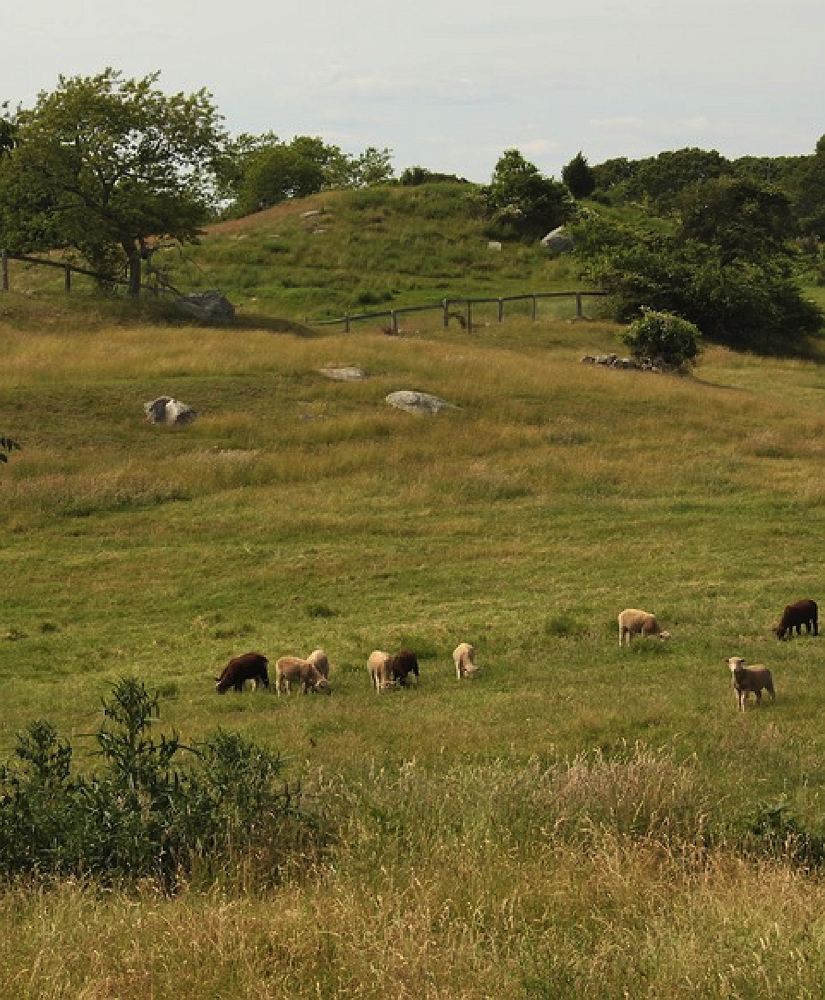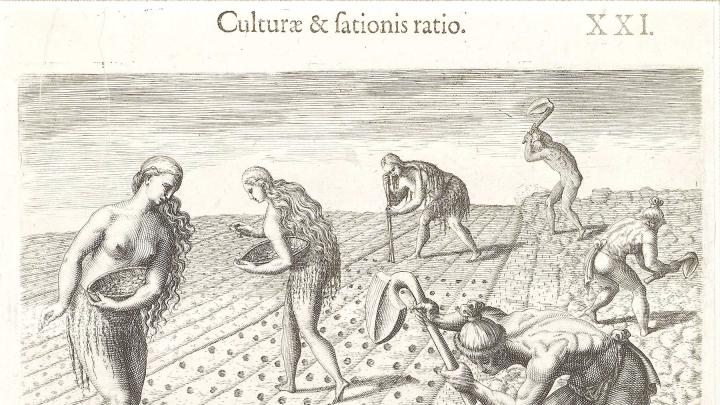What did the New England landscape look like before European colonizers arrived? The prevailing view among modern historians is that Native Americans engaged in widespread horticulture and used fire to keep grasslands and pasturelands open. Now a study by Harvard Forest director David Foster and colleagues, published today in Nature Sustainability, argues instead that Native Americans had very little impact on the regional landscape in that period, even when their populations were large.
The study reconstructs climate and vegetation in New England during the past 10,000 years, and draws as well on extensive archaeological evidence. It’s significant, Foster explained in an interview, because the relatively new belief that humans have always interfered in natural ecologies has been used to guide conservation practices in North America and elsewhere. The paper argues that this is a mistake, and that in the specific case of New England, “land managers seeking to emulate pre-contact conditions should deemphasize human disturbance and focus on developing mature forests.” In areas where grasslands and pasture are desired (for example, to retain modern patterns of species diversity), colonial-era technologies for keeping land open—such as plowing, grazing, mowing for hay, and tree-cutting—should be used instead of burning, because those are the agricultural approaches that created them four centuries ago. The larger implication is that the history of human involvement in ecologies elsewhere in North America and around the world may need to be re-evaluated.
Paleoecologist W. Wyatt Oswald, first author on the paper and an associate of Harvard Forest, used cores extracted from lake-bottom sediments to reconstruct prevailing patterns of vegetation from about 11,700 years ago, when the last glaciation ended. By analyzing pollen trapped in the sediment, he discovered which plants dominated the landscape; charcoal residues indicated the extent of burning. “When you actually look at various lines of evidence,” Oswald explained in an interview, “there is nothing to suggest that there were widespread human impacts on New England landscapes before the arrival of Europeans.”

The study authors analyzed pollen and charcoal residues in sediment cores (above) from lake bottoms to learn about changes in vegetation and the severity of forest fires in New England since the end of the last glaciation.
Photograph courtesy of the Harvard Forest
The research team collected sediment cores from 21 lakes across southern New England. Analysis revealed that pines dominated the landscape until 10,000 years ago. Then, as temperatures increased during the subsequent 2,000 years, oak forests began to appear, and elevated levels of pollen from ragweed and grasses indicate the presence of open land or an open forest structure maintained by fire, a change that was driven by the dry climate. Human populations at this point remained small. When moisture and temperature began increasing some 8,000 years ago, beech and hickory species joined the oaks, while signs of ragweed and grasses declined to almost nothing—indications that a closed-canopy hardwood forest had taken over the landscape, and that there was little fire, despite a burgeoning human population.

The study suggests that open land in New England should be maintained using the same colonial-era practices that created it, such as grazing and mowing, rather than burning.
Photograph courtesy of the Harvard Forest
Archaeological evidence tells a similar story of minimal human impacts on the ecosystem, one that accords with Native American cultural beliefs about living in harmony with the land. A spike in the Native American population that occurred from 1,500 to 500 years ago “has often been attributed to the emergence of horticulture,” the authors note, “especially the planting of maize.” But the archaeological evidence cited in the paper reveals very little sign of farming. There is, on the other hand, abundant evidence for subsistence practices such as hunting, fishing, shell-fishing, and plant-gathering. Elizabeth Chilton, an archaeologist and former assistant professor at Harvard who is one of the co-authors of the paper, quickly established during her time in Cambridge that cultivated corn, squash, and beans were present in New England before contact, but weren’t widely used until Europeans arrived.

David R. Foster (left) and W. Wyatt Oswald prepare to take a core sample of sediment from a lake in southern New England.
Photograph courtesy of the Harvard Forest
“People were still very much living off of the land,” said Foster, “which is why they congregated on the coast and in river bottoms” where there are so many resources. “That’s a shock for most people, because it’s so ingrained in us that the native people were planting corn.” It may be part of the national mythology, but “In fact, there’s no archaeological support for widespread use of agriculture at all.”
The Historical Fallacy
The idea that Native Americans engaged in widespread management of the landscape before European contact appears to have gained credence among scholars with a 1953 paper, “The Indian as an ecological factor in northeastern forests,” by anthropologist Gordon Day. Historian William Cronon’s Changes in the Land popularized the ideas that Native Americans were engaged in widespread horticulture, and used prescribed burns to keep grasslands and pasturelands open. Cronon relied on the accounts of early European explorers such as Thomas Morton, who described Native Americans setting such fires twice yearly, to conclude that:
Here was the reason that southern [New England] forests were so open and parklike; not because the trees naturally grew thus, but because the Indians preferred them so. As William Wood [in another early account] observed, the fire “consumes all the underwood and rubbish which otherwise would overgrow the country, making it unpassable, and spoil their much affected hunting.” The result was a forest of large, widely spaced trees, few shrubs, and much grass and herbage.
Foster himself recalled embracing these ideas about native burning to manage the land during his undergraduate studies, and noted that “Bill Cronon is such a marvelously accomplished writer that this idea has been taken up and applied widely. Books such as 1491 and various others on the ‘ecological Indian’ have really made this into something, such that modern-day land managers and the forest service and state agencies and conservation organizations—all have embraced this entirely—without any compelling prehistorical data.” As the study’s authors write:
Humans are now inferred to have driven ecosystem dynamics for millennia across much of the globe, including many areas formerly interpreted as pristine or dominated by mature forests. This new perspective has led to the conclusion that many valued characteristics of historical and modern landscapes, such as high levels of plant and animal diversity—including the occurrence of many rare and endangered species—may represent legacies of earlier cultural activities. In many forested or potentially forested landscapes, a wide array of openland habitats, including grasslands, shrublands, heathlands, and early successional forests have been attributed to purposeful landscape management by ancient people.
“This human-centered interpretation” has led to conservation management practices that include “the prescription of disturbances, especially fire,” as well as clear-cutting and other mechanical treatments to mimic the inferred activities of ancient peoples. In New England, where woodlands are often referred to as “the asbestos forest,” there are no fire-dependent species. “There are some species that will survive fire better than others,” Foster said, “but there are none that require fire in order to be maintained,” as there are in other parts of the country.
The present study, with its assembled empirical evidence from archaeologists, ecologists, and paleoclimatologists, is the culmination of a series of National Science Foundation grants on which Foster has been the principal investigator, combined with work done at the Harvard Forest as part of a long-term ecological research program. “We have been gradually building the number of sites,” said Foster, “and building a stronger and stronger case. Eventually, we were able to pull together the work that’s represented here.”
Their inescapable conclusion is that climate, not people, largely controlled fire severity in New England during the period since the end of the last glaciation. The paper’s conservation message is that “land managers seeking to emulate pre-contact conditions should deemphasize human disturbance and focus on developing mature forests: those seeking to maintain openlands should apply the agricultural approaches”—such as grazing, plowing, and mowing for hay—“that initiated them four centuries ago.”








